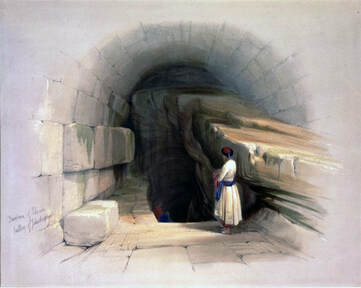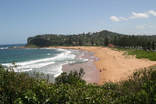
David had erected a special tent at Gihon to house the ark of the covenant. He put it there as a kind of faith marker for the permanent temple that God had put in his heart.
Gihon Spring entrance painted by David Roberts 1841
In Psalm 68 David envisages that temple as a reality, even though it would not be him but his son, Solomon, who would build it. Nevertheless, David prepared the way and prepared plans and materials. He often spoke, by faith, as though it was a reality.
Here he sees Israel’s enemies defeated and he sees the procession carrying God’s presence in the ark together with the singers and worshippers going to the temple to proclaim God as king over them. Even the enemies see it (v.24). He envisaged it as being just as it had been when he brought the ark to the temporary tent in the City of David, and housed it there, at Gihon.
But...notice what he says about the spring. It’s in verse 26 where he sees the congregation blessing the Lord, ‘FROM THE FOUNTAIN OF ISRAEL’ (NKJV).
That’s Gihon, the spring (Hebrew MAQOR, a spring or fountain) where David had erected the tent for the ark. That was ‘ground zero’, the ‘X’ that marked the spot—the sacred spot—known throughout the Old Testament as THE PLACE HaMakom.
That is where Solomon built the temple, near to and above the Gihon Spring, where the temporary tent had stood—not several hundred meters away up the hill on what erroneously became known as Temple Mount. The water from Gihon (meaning Gushing) was piped up into the temple precinct as several historic sources testify. This 'fountain of Israel' was the type, or illustration of the true 'Living Water' that Jesus later spoke of on that great day of The Feast, at the temple (the day when the water was poured--see John 7:37-39).
Read the entire gripping story of this site in 'THE PLACE, HaMakom: where Jerusalem's temples stood.'
Also vailable from Amazon
 RSS Feed
RSS Feed
